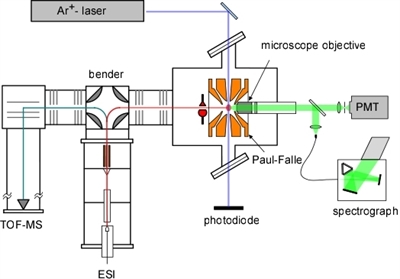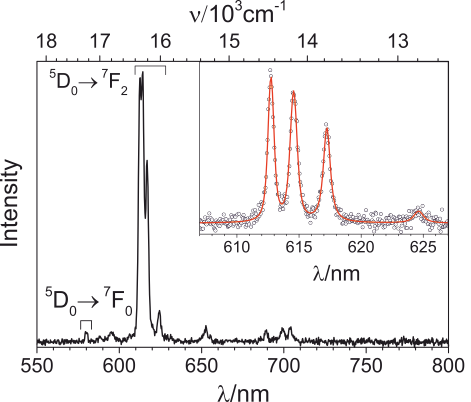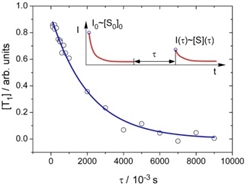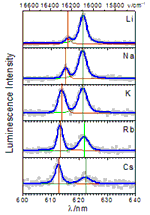Optical Properties of Isolated Molecules and Clusters
Trapped ion Laser Induced Fluorescence (TLIF) is an experiment for luminescence spectroscopy of isolated trapped ions in the gas phase. It combines the advantages of mass spectrometric analysis with laser induced luminescence characterization of the species studied. Ions are electro-sprayed using a nano electrospray ionization source (nano-ESI), trapped, mass selected and thermalized down to liquid nitrogen temperature in the center of a Paul trap. Trapped ions are excited by continuous wave lasers (argon ion-, diode- or dye-laser) crossing the ion cloud. Luminescence collected by an inverted microscope is either integrated using a photomultiplier or dispersed using a spectrograph coupled to a CCD camera. TLIF allows determination of intrinsic properties of organic and inorganic emitters. It provides information on energy levels of the emitting states, on the time constants of radiative and non-radiative processes (currently over the 10-6 to 102 s range), as well as on the influence of solvent interactions on the processes involved. TLIF offers unique capabilities such as the study of different charge and aggegation states as well as stoichiometries not available in condensed phase. It also allows performing reactivity studies between excited states and gas-phase species such as oxygen.
Trapped ions are excited by continuous wave lasers (argon ion-, diode- or dye-laser) crossing the ion cloud. Luminescence collected by an inverted microscope is either integrated using a photomultiplier or dispersed using a spectrograph coupled to a CCD camera. TLIF allows determination of intrinsic properties of organic and inorganic emitters. It provides information on energy levels of the emitting states, on the time constants of radiative and non-radiative processes (currently over the 10-6 to 102 s range), as well as on the influence of solvent interactions on the processes involved. TLIF offers unique capabilities such as the study of different charge and aggegation states as well as stoichiometries not available in condensed phase. It also allows performing reactivity studies between excited states and gas-phase species such as oxygen.
Bright Luminescence in Three Phases-A Combined Synthetic, Spectroscopic and Theoretical Approach.
 The photoluminescence of Au-M-M-Au (M=Cu, Ag, Au) “molecular wire” complexes was studied in detail by comparative measurements in solution, in the solid state and in the gas phase by TLIF and contrasted to time-dependent density functional theory computations. Angew. Chem. Int. Edit. 2021, 60, 23365
The photoluminescence of Au-M-M-Au (M=Cu, Ag, Au) “molecular wire” complexes was studied in detail by comparative measurements in solution, in the solid state and in the gas phase by TLIF and contrasted to time-dependent density functional theory computations. Angew. Chem. Int. Edit. 2021, 60, 23365
Vibronic coupling of the ligand-centered phosphorescence of gas-phase lanthanide complexes

Gas-phase laser-induced photoluminescence of cationic gadolinium and lutetium complexes involving two 9-oxophenalen-1-one ligands has been determined at 83 K. Comparison to DFT based harmonic Franck–Condon computations show, that the main vibrational contributions are well described, whereas the absolute transition energies are off by several thousand wavenumbers. This discrepancy is found to remain at higher computational levels, the relative energy of the Gd(III) and Lu(III) emission bands is only reproduced at the coupled-cluster singles and doubles level and beyond. Journal of Physical Chemistry A, 2018, 122, 2461
Correlation of structure, gas-phase photoluminescence and ion-mobility spectroscopy with DFT and ligand-field theory
The structural impact of coordinated alkali earth dications on the photoluminescence spectra was studied in a investigation of [Eu(PLN)4AE]+ with AE = Mg, Ca, and Sr, using TLIF, TIMS and DFT. In order to sort out the structural impact of the alkali earth dications on the photoluminescence spectra, the experimental data are compared to the predicted ligand-field splittings as well as to the collision cross-sections for different isomers of [Eu(PLN)4AE]+. Physical Chemistry Chemical Physics, 2017, 19, 6105
Nonanuclear Eu- and Gd-complexes
 We report the intrinsic luminescence properties of nonanuclear europium(III) and gadolinium(III) 9-hydroxyphenalen-1-one (HPLN)−hydroxo complexes. Luminescence spectra of [Eu9(PLN)16(OH)10]+ ions reveal an europium-centered emission dominated by a 4-fold split Eu(III) hypersensitive transition. The corresponding Gd(III) complex shows a broad emission from a ligand based triplet state with an onset of about 1000 wavenumbers in excess of the europium emission. As supported by photoluminescence lifetime measurements for both complexes, we deduce an efficient europium sensitization via PLN-based triplet states. The luminescence spectra of the complexes are discussed in terms of a square antiprismatic europium/gadolinium core structure as suggested by density functional computations. J. Phys. Chem. Lett, 2014, 5, 1727 and Inorganic Chemistry, 2016, 55, 3316
We report the intrinsic luminescence properties of nonanuclear europium(III) and gadolinium(III) 9-hydroxyphenalen-1-one (HPLN)−hydroxo complexes. Luminescence spectra of [Eu9(PLN)16(OH)10]+ ions reveal an europium-centered emission dominated by a 4-fold split Eu(III) hypersensitive transition. The corresponding Gd(III) complex shows a broad emission from a ligand based triplet state with an onset of about 1000 wavenumbers in excess of the europium emission. As supported by photoluminescence lifetime measurements for both complexes, we deduce an efficient europium sensitization via PLN-based triplet states. The luminescence spectra of the complexes are discussed in terms of a square antiprismatic europium/gadolinium core structure as suggested by density functional computations. J. Phys. Chem. Lett, 2014, 5, 1727 and Inorganic Chemistry, 2016, 55, 3316
Intrinsic fluorescence properties of rhodamine cations
 The gas phase triplet state lifetimes and dispersed fluorescence spectra of several types of rhodamine cations thermalized at 85 K have been investigated. The measured triplet lifetimes of rhodamine cations Rh6G+, Rh575+, RhB+, and Rh101+ are the order of seconds, several orders of magnitude longer than those typically observed for the same dyes in optical condensed phase measurements. Dispersed fluorescence emission spectra in the gas phase at 85 K have been measured and compared to density functional calculations. More see JPC A, 2010, 114, 5509-5514 and PCCP 2013, 15, 8162-8170
The gas phase triplet state lifetimes and dispersed fluorescence spectra of several types of rhodamine cations thermalized at 85 K have been investigated. The measured triplet lifetimes of rhodamine cations Rh6G+, Rh575+, RhB+, and Rh101+ are the order of seconds, several orders of magnitude longer than those typically observed for the same dyes in optical condensed phase measurements. Dispersed fluorescence emission spectra in the gas phase at 85 K have been measured and compared to density functional calculations. More see JPC A, 2010, 114, 5509-5514 and PCCP 2013, 15, 8162-8170
Europium complexes
 Gas phase dispersed photoluminescence spectra of europium (III) 9-hydroxylphenalen-1-one (HPLN) complexes cationized by alkali metals, [Eu(PLN)3M]+ with M=Li, Na, K, Rb, and Cs, have been studied. The mass selected alkali cation adducts display a split hypersensitive Eu3+ emission band. One of the two emission components shows a linear dependence on the radius of the alkali cation whereas the other component displays a quadratic dependence thereon. In addition, the relative intensities of both components invert in the same order. The experimental results are interpreted with the support of density functional calculations and Judd-Ofelt theory, yielding also structural information on the isolated [Eu(PLN)3M]+ chromophores. More see JPC A, 2013
Gas phase dispersed photoluminescence spectra of europium (III) 9-hydroxylphenalen-1-one (HPLN) complexes cationized by alkali metals, [Eu(PLN)3M]+ with M=Li, Na, K, Rb, and Cs, have been studied. The mass selected alkali cation adducts display a split hypersensitive Eu3+ emission band. One of the two emission components shows a linear dependence on the radius of the alkali cation whereas the other component displays a quadratic dependence thereon. In addition, the relative intensities of both components invert in the same order. The experimental results are interpreted with the support of density functional calculations and Judd-Ofelt theory, yielding also structural information on the isolated [Eu(PLN)3M]+ chromophores. More see JPC A, 2013
TLIF publications
- Bright Luminescence in Three Phases-A Combined Synthetic, Spectroscopic and Theoretical Approach.
Dahlen, M., Hollesen, E. H., Kehry, M., Gamer, M. T., Lebedkin, S., Schooss, D., Kappes, M. M., Klopper, W. and Roesky, P. W.
Angew. Chem. Int. Edit. 2021, 60, 23365
- Vibronic Coupling Analysis of the Ligand-Centered Phosphorescence of Gas-Phase Gd(III) and Lu(III) 9-Oxophenalen-1-one Complexes
J. Chmela, J.-F. Greisch, M. E. Harding, W. Klopper, M. M. Kappes and D. Schooss
Journal of Physical Chemistry A, 2018, 122, 2461
- Photodynamics and Luminescence of Mono- and Tri-Nuclear Lanthanide Complexes in the Gas Phase and in Solution
F. Liedy, F. Bäppler, E. Waldt, Y. Nosenko, D. Imanbaew, A. Bhunia, M. Yadav, R. Diller, M. M. Kappes, P. W. Roesky, D. Schooss, C. Riehn
ChemPhysChem 2018, 19, 3050
- Correlation of the structural information obtained for europium-chelate ensembles from gas-phase photoluminescence and ion-mobility spectroscopy with density-functional computations and ligand-field theory
J. F. Greisch, J. Chmela, M. E. Harding, D. Wunderlich, B. Schafer, M. Ruben, W. Klopper, D. Schooss and M. M. Kappes
Physical Chemistry Chemical Physics, 2017, 19, 6105 - Gas-Phase Photoluminescence Characterization of Stoichiometrically Pure Nonanuclear Lanthanoid Hydroxo Complexes Comprising Europium or Gadolinium
J. F. Greisch, J. Chmela, M. E. Harding, W. Klopper, M. M. Kappes and D. Schooss
Inorganic Chemistry, 2016, 55, 3316 - Photoluminescence Spectroscopy of Mass-Selected Electrosprayed Ions Embedded in Cryogenic Rare-Gas Matrixes
B. Kern, J.F. Greisch, D. Strelnikov, P. Weis, A. Bottcher, M. Ruben, B. Schafer, D. Schooss and M.M. Kappes
Analytical Chemistry, 2015, 87, 11901 - Characterization of Nonanuclear Europium and Gadolinium Complexes by Gas-Phase Luminescence Spectroscopy
J.-F. Greisch, M. E. Harding, B. Schäfer, M. Ruben, W. Klopper, M. M. Kappes and D. Schooss
Journal of Physical Chemistry Letters, 2014, 5, 1717
-
Effect of Proton Substitution by Alkali Ions on the Fluorescence Emission of Rhodamine B Cations in the Gas Phase
J.-F. Greisch, M. E. Harding, W. Klopper, M. M. Kappes, and D. Schooss
Journal of Physical Chemistry A, 2014, 118, 3787 - Substitutional Photoluminescence Modulation in Adducts of a Europium Chelate with a Range of Alkali Metal Cations: A Gas-Phase Study
J.-F. Greisch, M. E. Harding, B. Schäfer, M. Rotter, M. Ruben, W. Klopper, M. M. Kappes and D. Schooss
Journal of Physical Chemistry A, 2013, 118, 94 - Intrinsic fluorescence properties of rhodamine cations in gas-phase: triplet lifetimes and dispersed fluorescence spectra
J. F. Greisch, M. E. Harding, M. Kordel, W. Klopper, M. M. Kappes and D. Schooss
Physical Chemistry Chemical Physics, 2013, 15, 8162-8170 - Laser-Induced Fluorescence of Rhodamine 6G Cations in the Gas Phase: A Lower Bound to the Lifetime of the First Triplet State
M. Kordel, D. Schooss, C. Neiss, L. Walter and M. M. Kappes
Journal of Physical Chemistry A, 2010, 114, 5509-5514
